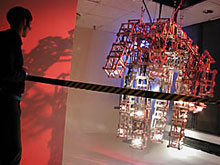You’re being watched: Artist creates seeing robot

An onlooker watches Yves' Bilodeau's piece Bedlam. His work was shown at the Deconism art gallery in Toronto.
Photo courtesy of Yves Bilodeau
Imagine that you are standing in a small, foggy room, surrounded by the sound of invisible agents that do not exist in reality as you know it. You’re being watched by something. You don’t see it, but it sees you, and it responds.
Such is the work of artist Yves Bilodeau, a self-taught roboticist who builds machines and gives them homes of sound and smoke. His latest project is a four-legged, six-armed robot, $20,000 worth of parts and circuitry suspended from the ceiling of the Deconism art gallery in Toronto.
“What I’m interested in making is a good show,” said Bilodeau, an associate professor in the Department of Studio Arts. He conducts his work through Hexagram, the independent research institute affiliated with Concordia and UQAM. “I’m interested in building a whole environment for the machine, so it includes sound, lighting, and using a lot of smoke.”
The 44-year-old Montreal native performs under the moniker Bill Vorn and has had over 20 exhibitions since his first collaboration 11 years ago with programmer/lighting designer Louis Philippe Demers.
Bedlam, his current project, is a collaborative effort with Simon Penny, an Australian robotic artist. The exhibit consists of two separate spaces: the physical space inhabited by the six-foot-tall robot, and a viewing space, a 10-foot open-walled cube where the robot will be able to watch the human viewer.
“The vision system is a four-camera digitizing kind of system, so we make a 3D model of the viewer,” Bilodeau explained. “From this 3D model we can extract certain information like the position of the head or the centre of mass, or the velocity of the two hands or feet.”
The movements of the viewer are represented by what Bilodeau calls Lego-Man, a blocky, low-resolution digital representation of the viewer, which in turn influences the movements and responses of the machine.
“It doesn’t really control the robot on a one-to-one kind of control,” he said. “The robot has certain pre-programmed movements and could be sort of influenced in the sense that sometimes it can go into one behaviour or another behaviour or a third behaviour, depending on what the viewer is doing. The set of all the different behaviours becomes its personality, so we just want the viewer to be able to influence the artificial personality of the machine.”
The information collected from the viewer will also influence a collection of invisible agents, virtual entities that don’t exist in physical space but affect the environment through an eight-speaker spatialized sound system that will emit human-type vocal noises. Spectators can also take a peek into the mind of the machine through a computer monitor, which displays the robot’s interpretation of the room, as well as the location of the agents.
Future incarnations of this project will see it multiplied by two: separate and isolated sites will be connected via the internet, with a viewing space and robot at each location. Each robot will be affected by what the local viewer does, as well as the behaviours of the remote viewer.
Like most of Bilodeau’s other work, the themes of space and interaction are heavily explored in this exhibit. The viewer is simultaneously spectator, intruder and catalyst, and is invited to ponder the oppositional themes of real and virtual, natural and artificial, life and death, man and machine.
“I also explore dysfunctionality and deviance in machinic behaviours, machines that don't do what we expect normal machines to do,” he said, stressing the importance of creating a context for these machines. “Building the whole thing and you put the machine inside and it becomes some sort of an artificial world for these creatures. This is what drives me, what my interest is.”